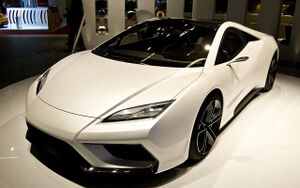Pantheon Dalliante
| Pantheon Dalliante | |
|---|---|
 2015 Pantheon Dalliante GT at the Rodzanican International Auto Show | |
| Overview | |
| Manufacturer | Pantheon Motor Company |
| Also called | Pantheon Dalliante Pantheon Model 37 |
| Production | July 1969-Present |
| Assembly | Izalgrod, Rodzanica |
| Body and chassis | |
| Class | Sports car S-segment |
| Body style | |
| Layout | mid engine, rear wheel drive |
| Powertrain | |
| Engine |
|
| Transmission |
|
| Dimensions | |
| Wheelbase |
|
| Length |
|
| Width |
|
| Height |
|
| Curb weight |
|
| Chronology | |
| Predecessor | Pantheon Model 35 |
The Pantheon Dalliante is a two-door, mid-engined, rear-wheel drive sports car manufactured by Pantheon Motor Company in Izalgrod, Rodzanica. Initially introduced in 1969, the Dalliante is one of the nation's longest continually manufactured marques; remaining conceptually unchanged for five decades since it's debut. It was initially developed as a spiritual successor to the older Model 35, utilizing the same air-cooled layout of it's predecessor - though packaged in a smaller and more affordable platform.
Sixth-Generation
Chassis
The Sixth-Generation Dalliante (internal designation Model 3552) was introduced in 2015 as an entirely new platform, featuring a lengthened chassis and upsized wheelbase. Simultaneously, front and rear overhangs were trimmed and the rear track was widened by 60mm over the outgoing design, markedly increasing passenger volume. The sixth-generation was the first to adopt multilink suspension - which, paired with the company's proprietary magnetoheological Magnetrack dampers, claimed to afford an over 23% improvement in lateral-G tolerance. The coupe is fitted as standard with four-wheel six-caliber ventilated disk brakes, though an optional upgrade to a tri-rotor carbon-ceramic package was offered on the GTS and GTR models. Steering is provided through a electromechanical rack-and-pinion system.
The new cars featured complete aluminium construction, built on a unitary chassis and assembled with self-piercing rivets. As a result, despite being larger and more powerful than previous model years, base sixth-generation Dalliantes had a 250 lb reduction in curb weight over their predecessors. To improve cornering traction, GTS and GTR variants were offered with Pantheon's intelligent electrohydraulic four-wheel steering; which, when combined with an overall increase in wheel footprint, provides particularly precise and agile cornering characteristics.
In the 2017 model year, Pantheon introduced a revised model of the Dalliante specifically meant for foreign export. The GTS and GTR models were both offered overseas starting in August of 2016, produced in both right and left-hand drive versions. Foreign variants were fitted with improved safety equipment, including lane assist and smart braking features, and priced at approximately $2,500 higher at MSRP over their domestic counterpart.
Engine
The Dalliante is offered in three trim levels: the GT, GTS, and GTR. Both the GT and GTS trims are offered with Pantheon's 24-valve DOHC 3.6 liter turbocharged six-cylinder engine, producing a peak of 375 horsepower (380 PS; 280 kW) and 310 lb/ft of torque (420 Nm). The GTR features a twin-turbo 4.0 liter powerplant, increasing output to 450 horsepower (455 PS; 335 kW) 380 lb/ft of torque (515 Nm). With the exception of the 4.2 liter engine in the limited-production 1972 Dalliante GTR, the four liter model is the largest powerplant fitted to any Dalliante to date.
The 3.6 liter variant is manufactured from high-silicon cast-aluminium, with an all-aluminium block and plasma-coated hypereuretic pistons. Fuel is fed through a dual direct and port injection system, running at a 12.5:1 compression ratio on 91 octane gasoline. In 2018, both the 3.6 and 4.0 models were revised with new exhaust manifolds, larger valves and revised ECU programming, marginally improving emissions and fuel economy. The engines are mated to a 7-speed dual-clutch automatic as standard, though a performance 7-speed manual is also offered for GTS and GTR models.
| Model | Year | Engine cc | Power | Torque | Compression Ratio |
|---|---|---|---|---|---|
| Dalliante GT | 2015-Present | 3,625 cc (221 cu in) I-6 | 375 bhp (280 kW; 380 PS) @ 6,500 rpm | 310 lb⋅ft (420 N⋅m) @ 6,500 rpm | 12.5:1 |
| Dalliante GTS | 2015-2018 | 3,625 cc (221 cu in) I-6 | 375 bhp (280 kW; 380 PS) @ 6,500 rpm | 310 lb⋅ft (420 N⋅m) @ 6,500 rpm | 12.5:1 |
| 2018-Present | 3,625 cc (221 cu in) I-6 | 385 bhp (287 kW; 390 PS) @ 6,500 rpm | 325 lb⋅ft (441 N⋅m) @ 6,500 rpm | 12.5:1 | |
| Dalliante GTS Supersport | 2015-2018 | 4,005 cc (244 cu in) I-6 | 450 bhp (336 kW; 456 PS) @ 6,700 rpm | 380 lb⋅ft (515 N⋅m) @ 5,900 rpm | 10.9:1 |
| 2018-Present | 4,005 cc (244 cu in) I-6 | 455 bhp (339 kW; 461 PS) @ 6,700 rpm | 390 lb⋅ft (529 N⋅m) @ 6,000 rpm | 11.0:1 | |
| Dalliante GTR | 2017-Present | 4,005 cc (244 cu in) I-6 | 455 bhp (339 kW; 461 PS) @ 6,700 rpm | 390 lb⋅ft (529 N⋅m) @ 6,000 rpm | 11.0:1 |
| Dalliante GTR Supersport | 2017-Present | 4,005 cc (244 cu in) I-6 | 520 bhp (388 kW; 527 PS) @ 7,000 rpm | 450 lb⋅ft (610 N⋅m) @ 6,200 rpm | 13.0:1 |
Performance